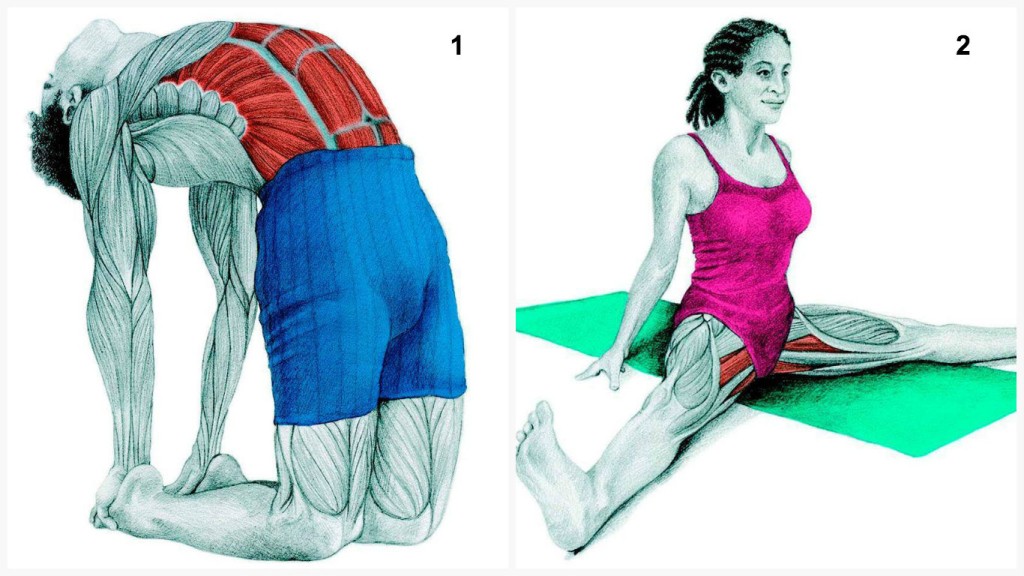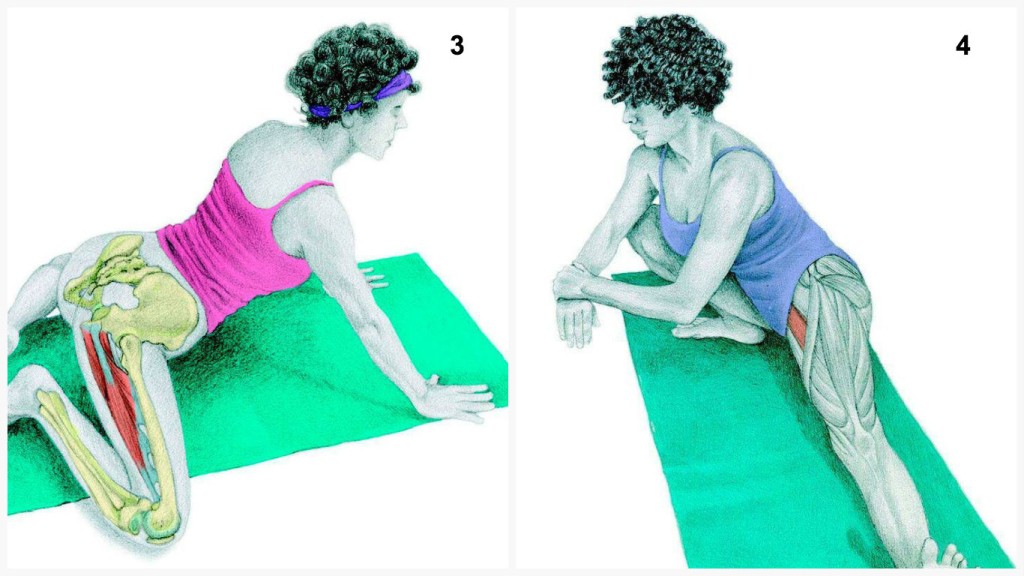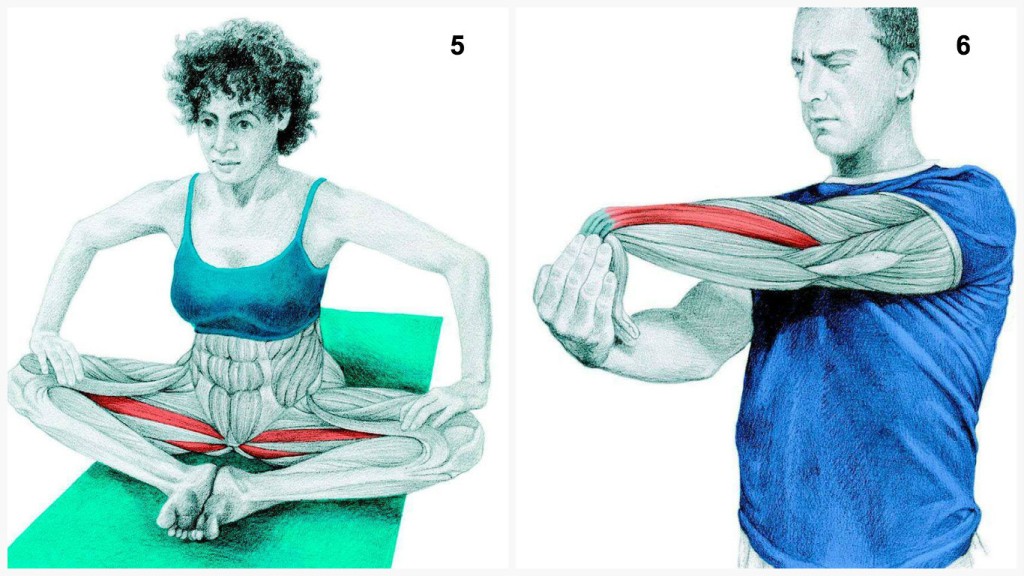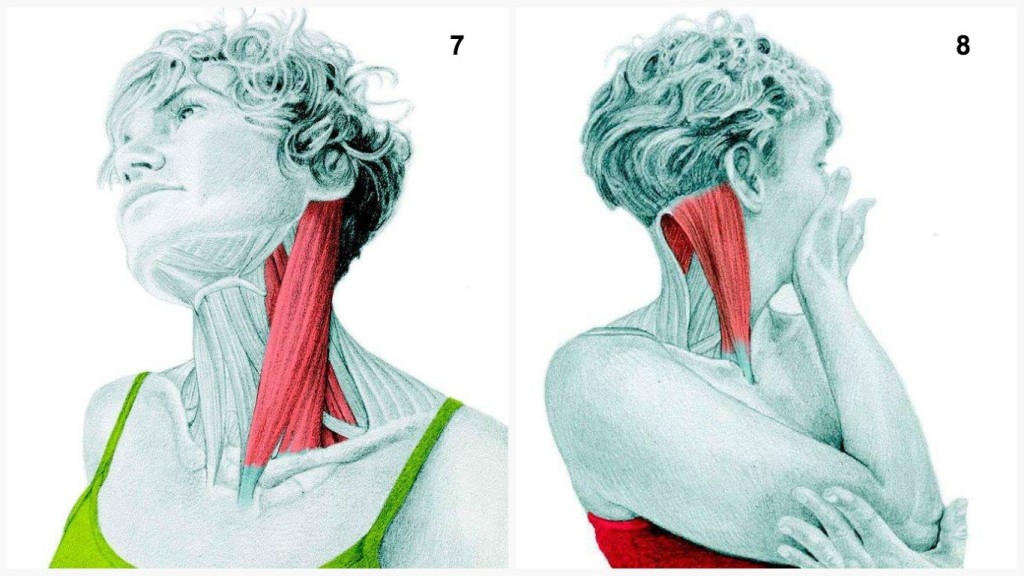36 Pictures To See Which Muscle You’re Stretching

27. Lateral Flexion with a Dowel
Muscles emphasized: external obliques and latissimus dorsi. Keeping your spine long, gradually push your hips out to the side while keeping your shoulders rotated outwardly. In case you have problems with your lower back, do not perform this stretch.
28. Triangle Pose
Muscles emphasized: external obliques. Begin with a wide stand and with your front foot straight ahead, and your back foot at 90 degrees. Put your hand on your front leg or on the floor, and sit back into your front hip, keeping your back straight. Rotate away from your front leg and maintain your look on the hand that it is in the air.

29. Chest Stretch at the Wall
Muscles emphasized: pectorals. For starters, face the wall with your thumb up. Gradually rotate away from the wall in order to stretch your chest muscle. This stretch should be felt in the belly of the muscle, but be careful not to stretch too far, as it will result in a pain in the shoulder joint.
30. Assisted Chest Stretch
Muscles emphasized: chest and latissimus dorsi. Begin by lying down on the floor and holding your palms faced up. Your partner should be seated in a deep squat and hold your hands, thus, you are supposed to feel a stretch in your chest and lats. The stretch should also cause some traction in your spine. If you have shoulder impingement, do not perform this stretch.

31. Seated half Pigeon Variation
Muscles emphasized: anterior tibialis. Begin by sitting with your feet positioned in front of you. Put one hand behind you and rotate your hip outwardly and put one foot above your knee. If you want to add to the stretch on your hip, gradually lean forwardly and start the movement by hinging at the hips.
32. Supine Shoulder External Rotation Stretch
Muscles emphasized: subscapularis. Begin by lying flat on your back. Then, place your arm straight out to the side with your elbow at an angle of 90 degrees. Next, gradually bring the back of your hand to the floor. If you cannot bring your hand close to the floor, and it is still far away, it means that your rotator cuff and other muscles that control internal rotation are tight.

33. Down Dog Variation at the Wall
Muscles emphasized: pectorals and latissimus dorsi. Stand far enough from a wall or rack so that when you touch the wall your body gets into parallel position to the ground. Move into this position by pivoting at the hips and make sure your spine is straight all the time. Once in this position, move your chest forward and make a slight arch in your upper back and stretch your lats and chest muscles. If your hamstrings are tight, try bending at the knees.
34. Assisted Chest Stretch Variation
Muscles emphasized: pectorals. Lye down on the floor with your face down and your palms faced down. Your partner should pull your hands back and you should feel a deep stretch in your chest muscles. In case you have a shoulder impingement, do not perform this stretch.

35. Standing Upper Trapezius Stretch
Muscles Highlighted: Upper Trapezius Muscle. Stand erect and move your hands behind your lower back. Grasp your right wrist with your left hand. Pull your right arm as far as possible to the left. Your hands should be in back, or just outside of, your left hip. Lower your head sideways, toward your left shoulder, until you feel the stretch in your neck. Maintain the stretch for 30 seconds and then repeat it on the opposite side.
36. Standing Upper Back Extension
Muscles Highlighted: The Teres Major, Rhomboid and Upper Trapezius Muscles. Stand erect and place your feet close next to each other. Extend your arms in front of you with your fingers interlaced and your palms facing forward. Lowering your head slightly forwards, push your hands frontward while exhaling, allowing your back to arch slightly while your knees are bending. Hold for 10 to 15 seconds.
Don’t Forget To Share With Your Friends And Family On Facebook, And Check Our Youtube Chanel If You Want To See This Article In The Form Of Video!
Source: www.lifehack.org
You should all know that you need to stretch, whether you are a chronic sitter, a weekend warrior, or a daily exerciser. Stretching helps your blood reach your muscles and your joints move through their full range of motion, but it also improves your posture and athletic performance and reduces the risk of injuries and pain.
How do you know which muscles you are actually stretching or if you are performing each stretch the right way while you do yoga or the flexibility routine?
Well, here is a little knowledge on the topic, and having this in your back pocket, you can opt for the best stretches that best fit your goals. In case you start feeling pain, and not the regular, good pain, but the stretchy one when you know that something does not feel right, you should pinpoint the muscle that gives you the trouble and change the technique you have been using in order to avoid getting injured.
These stretches should be felt in the belly of your muscle. However, you should not feel pressure or strain in your joints, and if you do, it means that you are pushing too far. During the stretching, concentrate on your breathing and make sure these movements are as natural as possible.

Stop thinking about the time you are holding the stretch, but instead, start concentrating on feeling your muscles relaxing and returning to their natural, resting length. This may take about five to thirty seconds. If a stretch does not feel like it is doing something for your body muscles, change it and try another one.
The beautiful illustrations we present you are made by Vicky Timon, a yoga expert and author of “Encyclopedia of Pilates Exercises”, and James Kilgallon, CSCS, creator of Mazio’s Body Maintenance Program, contributed by giving the expert commentary.

1. Camel Pose
Muscles emphasized: Rectus Abdominus and External Obliques. This stretch is though most appropriate for people who already have a good flexibility. Sitting on your heels, put your hands behind you, pushing your hips up and forward. Do not put too much pressure on your lumbar spine. Also, in case you have problems with your neck, do not drop your head back.
2. Wide Forward Fold
Muscles emphasized: adductors. This exercise is great for stretching the adductors and the hamstrings, and you just need to open the hips. Start with your knees bent, holding your spine straight. As you start feeling your muscles starting to release, straighten your legs, round out your back and reach for your feet. Pull easily on the bottom of the balls of your feet in order to release the calf muscles. If you are beginner, you might not be able to reach your feet, so then you will need to use a belt or a towel. This stretch can also be performed while you lye on your back and push your legs up the wall.

3. Frog Pose
Muscles emphasized: adductors. This stretch for your groins can put pressure on your knees as well, so it is recommended that you perform it on a soft surface. Rest your hands and knees, and then bring your knees wider until you feel your groin muscles well stretched. You will feel a bit differing stretches as you actively push your hips back and forward.
4. Wide Side Lunge Pose
Muscles emphasized: adductors. Begin by putting your both feet forward in a wide stance, holding your legs as straight as possible. With your hands, walk to your right foot and then bend your right knee and rotate your left toes up to the ceiling, sitting in your right hip. Make sure your right foot maintains flat on the ground.

5. Butterfly Stretch
Muscles emphasized: adductors. Sitting, bring the soles of your feet together and sit tall through your sit bones. Develop this stretch by putting pressure on your knees, using your hands. If you want to stretch your groin muscles better, hold your feet closer to your body. Now, make sure your feet are far from your hips and slowly round your upper body to loose your back muscles.
6. Forearm Extensor Stretch
Muscles emphasized: Forearm extensor. Pack your shoulders and your back down and rotate the shoulder towards outside in order to get into the optimal position to stretch the forearm muscle. After you have managed to bring your body into this position, put pressure on your other hand to start the stretch. You can develop this stretch by touching the tips of your fingers together in the shape of a tea cup.

Continues on page 2…
